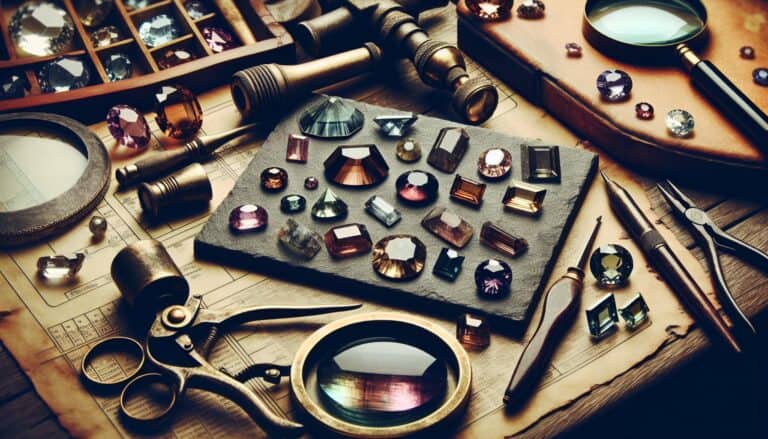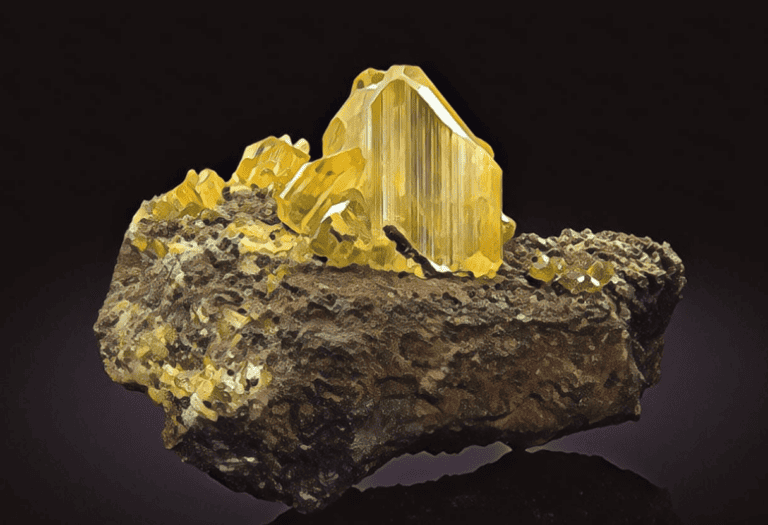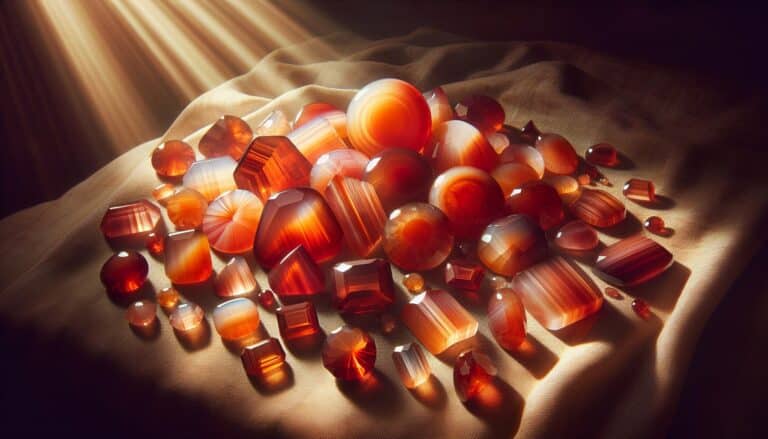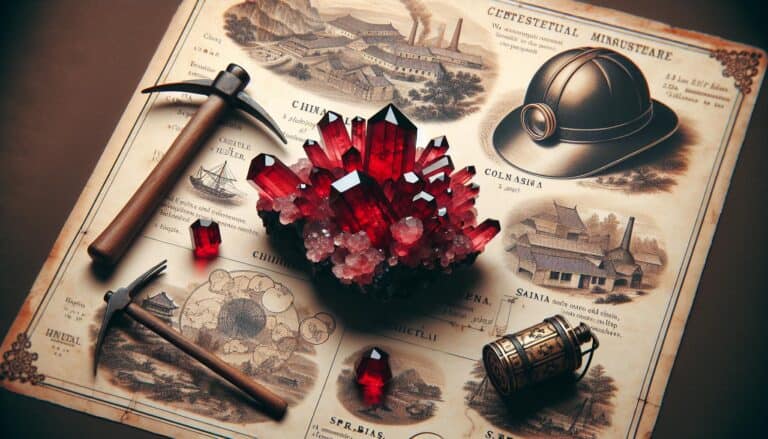If you’re itching for an adventure that combines the thrill of discovery with the beauty of nature, rockhounding in Washington State is your perfect escape.
With its diverse geology, the Evergreen State is a treasure trove for enthusiasts and beginners alike, offering a unique opportunity to unearth some truly remarkable finds.
From the sun-drenched deserts to the rugged coastlines, Washington’s landscapes are as varied as the minerals you can collect. Whether you’re after sparkling geodes, ancient fossils, or the elusive Ellensburg Blue agate, you’ll find that each locale offers a distinct rockhounding experience.
Let’s dig into the top spots where you can scratch that rockhounding itch and what hidden gems await you there.
Rockhounding in Washington State offers diverse experiences, from quartz crystals at Hansen Creek to garnets near Lake Chelan and agates at Ocean Shores. Visit Red Top Mountain for fire opals or Walker Valley for geodes. Respect land rights and stay informed about local regulations for a fulfilling rockhounding adventure.
Get our FREE United States Rockhounding Map HERE
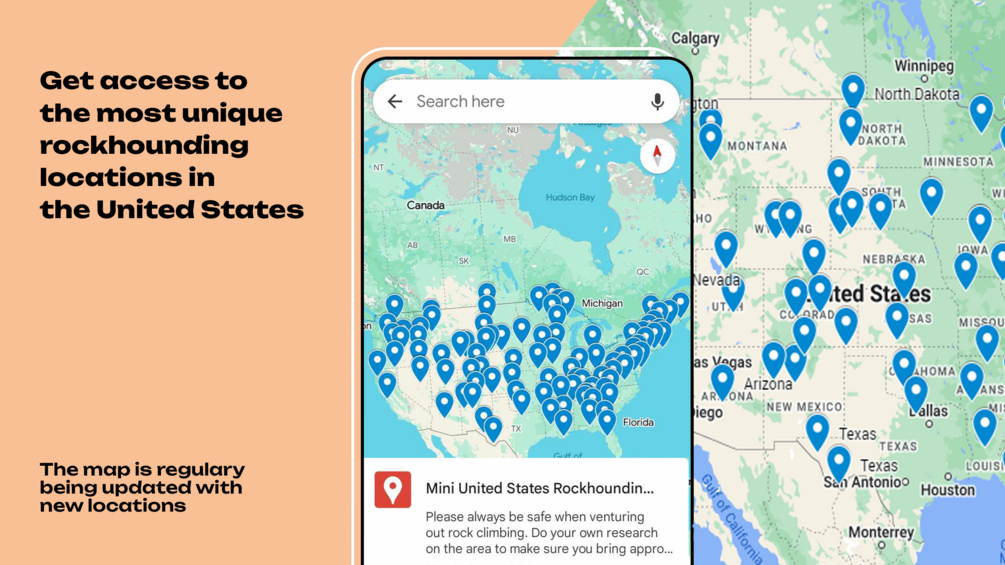
Washington State Rockhounding Locations
Embarking on your rockhounding adventure, Washington State is dotted with sites that cater to both novices and seasoned collectors. You’ll discover unique geological treasures that reflect the state’s rich volcanic history and sedimentary processes.
Hansen Creek, tucked away in the Snoqualmie Region, is famous for its abundance of quartz crystals. Here, patience and a keen eye could reward you with amethysts and clear crystals hidden among the rugged terrain.
Next, envision the sun setting over the Cascade Mountains as you sift through the sediments at First Creek near Lake Chelan. This locale is renowned for garnets – deep red gems that are both stunning and relatively easy to find.
For a coastal experience, head over to Ocean Shores, where agates and jaspers wash ashore, waiting to be uncovered by beachcombers. It’s an ideal spot for family outings as the gem hunt combines easily with a seaside vacation.
In the eastern part of the state, the high desert landscape of Red Top Mountain beckons rockhounds with its promise of fire opals. Venturing there, you might also stumble upon the occasional geode, offering a literal glimpse into the Earth’s hidden beauty.
Be sure to check out Walker Valley, located in Skagit County, where a collection of geodes, calcite, and opal awaits. This site requires tools and a bit of digging; therefore, come prepared for a full-fledged rockhounding expedition.
While these locations are just the tip of the iceberg in terms of rockhounding sites in Washington, they’re essential stops on your quest for geological wonders. Remember, each site has its regulations and seasons, so always conduct thorough research or consult local guides before digging in.
- Top Rockhounding Locations in Washington State:
- Hansen Creek: Quartz Crystals, Amethysts
- First Creek: Garnets
- Ocean Shores: Agates, Jaspers
- Red Top Mountain: Fire Opals, Geodes
- Walker Valley: Geodes, Calcite, Opal
As you set out to explore these areas, keep in mind that rockhounding isn’t just about the finds—it’s about connecting with nature and discovering the ancient stories told by stones.
What Gemstones are Found in Washington State?

Washington State is known for its cornucopia of gemstones – a real treasure trove for rockhounds like you. Amidst the evergreen richness and the rugged landscapes, you’ll find a variety of gleaming gemstones that are both rare and fascinating.
Jade, for example, is a prized find in Washington State. This gemstone, with its lustrous green color, can often be found in the rivers and streams of the western part of the state. In particular, the Green River has been noted for jade discoveries. Additionally, there’s quartz, ranging in clarity and color, which beckons many amateur geologists to the Cascade Mountains.
On the eastern side of the Cascades, the Yakima River holds ample opportunities for those in pursuit of agate and jasper, stones renowned for their intricate patterns and captivating colors. These finds can make an exceptional addition to your collection and are often usable in jewelry.
Petrolized wood, or petrified wood, is another find in Washington that resonates with history. The aptly named Petrified Wood Gallery in Vantage showcases samples of spectacular quality, which you might find replicated in your own searches in the surrounding area.
| Gemstone | Notable Locations |
|---|---|
| Jade | Green River |
| Quartz | Cascade Mountains |
| Agate | Yakima River |
| Jasper | Yakima River |
| Petrified Wood | Petrified Wood Gallery, Vantage |
Diamonds might be less expected, but Washington has its share of these precious stones as well. The Crater of Diamonds in the Cascade Range is a notable place where you can try your luck.
What Sedimentary Rocks You Can Find in Washington State?

While exploring the verdant landscape of Washington State, you’ll find a rich tapestry of sedimentary rocks that have been shaped over millions of years. These layers of Earth’s history are waiting for you to uncover them, offering a unique glimpse into the geological past.
One of the most accessible sedimentary rocks in Washington is sandstone, particularly noted for its presence in the Puget Sound area. Along the banks and cliffs, you can observe the intricate patterns formed by this sedimentary rock, which comes in various hues. The Chuckanut Formation is especially renowned for containing well-preserved sandstone that captures the imagination of rockhounds.
Washington’s riverbanks and coastal areas are good places to find shale. This fine-grained sedimentary rock splits into thin, distinct layers, and often houses fossils of ancient plants and marine life. As you gently split the layers, you might unveil imprints that tell the story of prehistoric Washington.
Another notable find in Washington’s sedimentary family is limestone. While it’s less common than other sedimentary types, the Hozomeen Group of northern Washington boasts high-quality limestone, tucked away in the rugged terrain of the North Cascades. If you venture there, you’re likely to spot the subtle, yet distinctive sparkle of calcite crystals embedded within the rock.
While sedimentary rocks may not typically glitter like gems, they hold a different kind of treasure—the secrets of Earth’s ancient environments. As you search, you’re engaging with the pages of our planet’s deep history laid bare in stone.
Remember to respect the beauty and integrity of these natural formations. Leave no trace of your visit, apart from the memories and perhaps a few legally collected samples that you’re allowed to take home. Always check local guidelines and obtain necessary permits, ensuring your rockhounding adventure is both rewarding and responsible.
What Metamorphic Rocks are found in Washington State?
Washington State’s geology offers a diverse range of metamorphic rocks, each bearing evidence of the region’s dynamic geological history. These rocks have undergone profound transformations through heat, pressure, and chemical processes, resulting in a variety of unique and sought-after specimens for rockhounding enthusiasts.
Among the treasure trove of metamorphic rocks, schist is one you’ll encounter frequently in the Cascade Range. It’s identifiable by its foliated layers, which make it a favorite among collectors for its distinctive appearance. The varying minerals within schist give it a diverse color palette, which often includes shades of gray, brown, and green.
In the northeastern part of the state, gneiss emerges as a dominant metamorphic rock, characterized by its banded texture and is often intermingled with quartz. If you’re searching for something with a more dramatic visual, the marbled patterns of gneiss can be quite astonishing and are a testament to the extreme conditions required for its formation.
Another metamorphic rock found in the heart of Washington’s rockhounding locales is marble. This metamorphosed limestone is primarily found in the Okanogan Highlands and is revered for its use in sculpture and architecture, as well as its aesthetic appeal in a collector’s display.
Quartzite, a hardened form of sandstone that’s undergone metamorphism, can also be unearthed in Washington. This durable rock is well-known for its glassy luster and resistance to weathering, making it a common find in regions exposed to severe geological activity.
When you’re out exploring for these metamorphic wonders, be sure to keep an eye out for phyllite and slate as well. Phyllite, with its fine-grained layers and a subtle sheen, marks an intermediate stage between slate and schist. It’s often found in the areas surrounding the North Cascades. Slate, which is predominantly found in Western Washington, is popular for its use in tiling and is easily recognized by its distinctive cleavage and smooth feel.
Be mindful that each location harboring these rocks will have its own regulations and guidelines. Always research and seek permissions where necessary, ensuring that your rockhounding practice is both enjoyable and responsible.
What Igneous Rocks can You Find in Washington State?
While exploring Washington State’s diverse geological landscape, you’ll encounter a variety of igneous rocks – the solidified forms of molten magma. Granite and basalt are the most prevalent, with the latter covering significant portions of the state’s geography.
Granite, with its coarse-grained texture and robust nature, is commonly found in the North Cascades. Here, you can witness the majestic mountain ranges composed largely of this igneous rock. Its crystal-clear minerals like quartz, feldspar, and mica sparkle under the sunlight, luring rockhounds to seek out its beauty.
Basalt flows dominate the eastern side of Washington, particularly within the Columbia River Plateau. The Columbia River Flood Basalts are famous for their extensive lava flows and columnar jointing. These features provide a striking spectacle and a prime opportunity for rock collectors to find well-formed basalt columns and samples.
In addition to granite and basalt, andesite and rhyolite are also found scattered across the state. You’ll find andesite in the western regions where volcanic activity once shaped the land. Andesite is medium-grained and often bears a gray to greenish hue.
On the other hand, rhyolite – known for its light color and fine-grained texture – can sometimes be located in the areas around old, extinct volcanoes. While not as prevalent as other igneous rocks in the region, rhyolite’s presence signifies the explosive volcanic history Washington State has experienced.
When planning your rockhounding trip, make sure to research specific areas where these igneous rocks can be legally collected. Public lands and designated rockhounding sites offer the best chances to add these igneous treasures to your collection, always remembering to adhere to the Leave No Trace principles to preserve these geological wonders for future generations.
Panning for Gold in Washington State
Gold panning in Washington is a popular activity for rockhounds and adventure seekers alike. The state is riddled with rivers and creeks known to bear placer deposits where you can try your luck at finding gold. Significant gold finds have been located in the Columbia and the Snake Rivers along with their tributaries. Don’t miss the Liberty area in central Washington, or the Republic district in the northeastern part of the state, well-known spots among seasoned prospectors.
Before you set out with your pan and shovel, be sure you’re up to date on the state’s regulations. Washington requires specific permits for mineral prospecting and placer mining in certain areas, so it’s crucial to research the location you plan on exploring. Forest service maps and state regulation booklets can be indispensable tools in planning your gold panning expedition.
Here’s what you might find:
- Fine gold particles, often hidden within streambeds
- Gold nuggets, although rarer
- Other minerals like silver and copper as byproducts
When panning for gold in Washington, the right technique is just as important as the location. You’ll need to be patient, using a circular motion to allow the lighter material to spill out of the pan while heavier gold remains. Remember, spring and early summer are often the best times to pan for gold, as winter runoff washes new layers of gold into the streams.
To maximize your chances of success, consider joining a local prospecting club. These clubs often offer valuable insights, tips, and even access to private claims where you’re more likely to strike gold.
- Always follow Leave No Trace principles
- Expect to find mostly small gold flakes; nuggets are a bonus
- Enjoy the natural beauty of Washington’s landscapes as you search
Whether you find gold or not, the experience of being in the wild, with the clear waters and rich earth, is truly rewarding. Panning in Washington State doesn’t just offer the potential for great finds, it’s an opportunity to connect with nature and history.
Rocks and Minerals Found in Washington State
As you scour the diverse terrains of Washington State, you’ll find that it’s teeming with a rich variety of rocks and minerals. Petrified wood is a notable treasure, and the state is so proud of this gemstone that it’s designated as the official state gem. Petrified wood is mainly found in the Ginkgo Petrified Forest State Park, where collecting is prohibited; however, surrounding sites offer opportunities for enthusiasts.
Jasper, agate, and opal are also plentiful in the Washington landscape. For agate hunters, the beaches along the Olympic Peninsula are your go-to spots, especially after a storm when fresh material is churned up. Agates here bear a characteristic blue-grey sheen, making them easily distinguishable amongst other pebbles.
Washington’s volcanic history has gifted rockhounds with an abundance of obsidian. While it’s commonly found in various locations, the Glass Buttes are particularly renowned. Here you can find pieces ranging from translucent to deep black. Always check property regulations, as some obsidian sites may be on private land.
For those captivated by crystals, Quartz varieties, including amethyst and citrine, decorate the state’s rocky locales. Crystal-seeking can be especially rewarding in the Cascade Mountains, where geothermal activity has churned out these beautiful formations. Remember to bring tools suitable for hard-rock digging, as these treasures often require some effort to unearth.
For a comprehensive view of all the noteworthy rocks and minerals you can find in Washington State, consider the following:
- Petrified Wood
- Agate
- Jasper
- Opal
- Obsidian
- Amethyst
- Citrine
Whether you’re searching riverbanks, scouring mountainous outcrops, or digging in ancient lava flows, Washington State offers a rockhounding experience as rich and varied as the minerals waiting to be discovered. Remember your rockhound etiquette—respect private property, keep to designated areas, and leave no trace behind.
Where Can I Find Fossils in Washington State?
Unearthing fossils in Washington State can be an exciting venture for rockhounds of all levels. The state’s geological history offers a vast array of fossilized specimens that add an intriguing dimension to your rockhounding adventures.
In the central part of the state, the Saddle Mountains are renowned for their abundance of plant fossils. As you scour the mountain’s sediments, look for the well-preserved impressions of Gingko, Metasequoia, and various fern species. Remember that fossil collection here is subject to strict regulations, so it’s crucial to stay informed about the current rules.
Head over to Republic, WA, and you’ll find the internationally famous Stonerose Interpretive Center and Fossil Site. Here’s your chance to dig for fossils that are up to 49 million years old. The site is particularly famous for its delicate leaf impressions and insect fossils from the Eocene epoch.
If marine fossils are more your thing, then the Westport Beach area along the Pacific coast is your go-to spot. Among the graywacke sedimentary rocks, you might stumble upon fossilized shells and even the occasional whale bone. Beachcombing after a storm can often yield the best results, as the turbulent sea uncovers hidden treasures.
When looking for fossils, always ensure that you’re not on private property without permission and that you adhere to local fossil collection laws. Many fossil sites are in protected areas where collecting is not allowed, but local museums and visitor centers can often provide information about where you can legally search.
Here’s a quick rundown of places to potentially find fossils in Washington State:
- Saddle Mountains: plant fossils
- Stonerose Interpretive Center: leaf and insect fossils
- Westport Beach: marine fossils
Remember, while rockhounding for fossils, use non-destructive methods to collect and always aim to minimize your impact on the environment.
Washington State Rockhounding Laws & Regulations
When you’re rockhounding in Washington State, knowing and adhering to the local laws and regulations protects both you and the environment. Whether you’re a novice or an experienced collector, it’s crucial to understand these rules before setting out on your adventure.
Land Ownership and Permission are significant factors in rockhounding. It’s essential to determine if an area is public land, private property, or part of a mining claim. On public lands, such as those administered by the Bureau of Land Management (BLM) or the United States Forest Service (USFS), you’re generally allowed to collect rocks and minerals by hand for personal use. However, collecting on private property requires explicit permission from the owner.
The Quantity and Equipment restrictions also play a vital role. Most public areas limit the amount of material you can collect – typically up to 25 pounds per day, plus one piece, with a maximum of 250 pounds per year. Mechanical equipment, explosives, or vehicles are not allowed for rockhounding on public lands.
Be aware of Designated Areas. Certain regions, such as National Parks and State Parks, have different rules and may not allow rockhounding at all. Always check the regulations specific to the park you’re visiting.
Protecting Cultural Heritage and Natural Features is non-negotiable. It’s illegal to collect artifacts, petrified wood, or objects of antiquity on public lands without a permit. Washington State places a strong emphasis on preserving its natural and historical sites, so take care not to disrupt or remove any such features.
Be sure to stay updated on regulations, as they can change. Before heading out, contacting the local field office or checking online resources for the latest guidelines will ensure your rockhounding experience is both enjoyable and compliant. Remember, being a responsible collector not only ensures that these treasures will be around for future generations, but it also safeguards your ability to continue this rewarding hobby.
Rockhounding Tips for Beginners in Washington State
Gearing Up: Essential Tools for Rockhounding
Stepping into rockhounding, it’s vital to equip yourself with the right tools. Gearing up properly ensures a fruitful and enjoyable venture. Begin with the basics:
- A durable geologist’s hammer or rock pick for extracting specimens
- Safety goggles to protect your eyes from flying debris
- Gloves to safeguard your hands from sharp rocks and rough surfaces
- A sturdy backpack to carry your finds and tools
- Adequate footwear, preferably hiking boots, to navigate rough terrains
- A field guidebook to help identify rocks, minerals, and fossils
Remember to pick tools that are fit for purpose, and durable as the rugged terrains of Washington State won’t go easy on flimsy equipment.
Safety Tips While Rockhounding
Rockhounding can be an adventure, but safety should always be your top priority. Here are critical tips to keep in mind:
- Stay aware of your surroundings, especially when hammering or chiseling rocks.
- Keep a well-stocked first aid kit handy for any minor injuries that may occur.
- Always tell someone where you’re going and when you expect to return.
- Bring sufficient water and sun protection, especially during the warmer months.
- Check the weather forecast, and plan accordingly to avoid getting caught in adverse conditions.
- Be mindful of wildlife, and learn how to recognize and avoid potentially dangerous animals.
Paying attention to safety ensures you enjoy your rockhounding experience without hazardous setbacks.
Legal Guidelines for Rockhounding Enthusiasts
Keeping on the right side of the law ensures that your rockhounding activities are both ethical and sustainable. Keep these pointers in mind:
- Always obtain permission from landowners before rockhounding on private property.
- Familiarize yourself with the collection limits, both in quantity and size, as stipulated by state and local laws.
- Use hand tools only; mechanical devices are often prohibited or require special permits.
- Respect designated areas, and do not collect where prohibited by law, such as in National Parks.
By adhering to legal guidelines, you help preserve Washington State’s natural heritage, ensuring that it remains available for future generations of rockhounders.
Conclusion: Washington Rockhounding Guide & Map
Embark on your next adventure with confidence, knowing you’re well-equipped to explore Washington State’s rich geological playground.
Remember, adhering to the rules ensures that these treasures will be around for years to come. So grab your gear, respect the land, and happy hunting! Whether you’re after sparkling geodes, colorful agates, or the elusive petrified wood, your discoveries await.
Washington’s diverse landscape is your canvas; go create your masterpiece.




